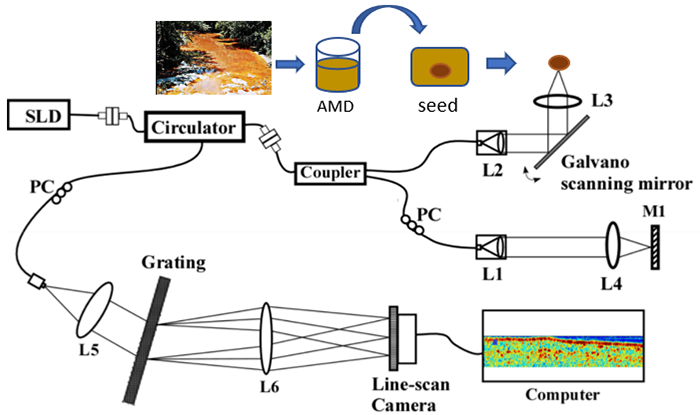Profile

Nationality : Chinese
Keywords : OCT(Optical Coherence Tomography), AMD(Acid Mine Drainage), phytoremediation, seed germination
Research advisor : Prof. Hirofumi Kadono
Why I entered GSC program
At present, there are physical methods for acid mine wastewater remediation, including ion exchange method, adsorption method and membrane technology etc. Chemical methods include acid-base neutralization method, chemical precipitation method and electrochemical method etc. Biological methods include phytoremediation and microbiological methods. Phytoremediation is gaining attraction from researchers because of its low cost and non -generation of secondary pollution. In the process of selecting remediation plants, traditional chemical monitoring methods usually employ techniques such as enzyme activity and metabolite analysis. However, these methods require a lot of monitoring time and are damaging to plants, and thus not conducive to dynamic monitoring of different stages of the same sample. Therefore, there is a need for the development of techniques that can monitor the effects of AMD speedily and noninvasively.
Research title
Biospeckle optical coherence tomography in monitoring the effect of Acid mine drainage (AMD) on seed germination
Research abstract
In the process of mining mineral resources such as coal and metals, due to the oxidation of sulfide minerals contained in the minerals, a large amount of mine wastewater is generated. Such mine wastewater has the characteristics of low pH (2-3), high level of Fe ions, and high SO42-, so it is called acid mine drainage (AMD). At present, AMD is one of the most serious problems for global mining industry and its phytoremediation has attracted much attention from researchers all over the world. Optical Coherence Tomography (OCT) is a promising technology that is widely used for structural mapping. Speckles observed in OCT has the potential to map structural changes or in other words the dynamic activity within the plants. We proposed a biospeckle optical coherence tomography (bOCT) and demonstrated that the technique could monitor the changes in plant under the influence of environmental conditions. In this study, we apply bOCT and focus on the effect of AMD on the germination of rice seed and growth of the seedlingand demonstrate that a more efficient method can be used to monitor plant response to AMD. This method may provide a new non-destructive parameter,biospeckle contrast, for selecting suitable plants in phytoremediation experiments.
Graphical abstract




